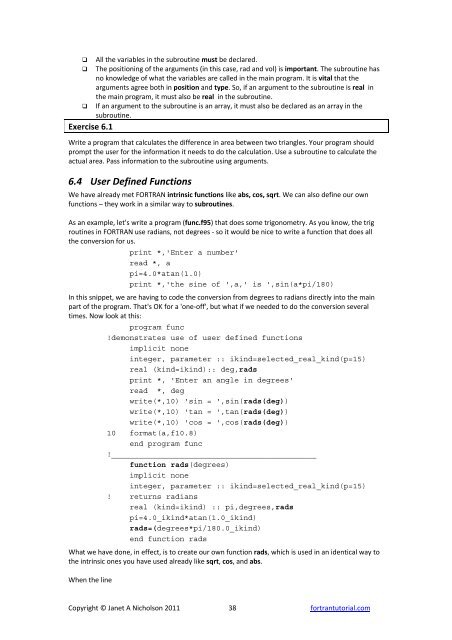6 Subroutines and Functions - FORTRAN Tutorial
6 Subroutines and Functions - FORTRAN Tutorial
6 Subroutines and Functions - FORTRAN Tutorial
You also want an ePaper? Increase the reach of your titles
YUMPU automatically turns print PDFs into web optimized ePapers that Google loves.
All the variables in the subroutine must be declared.<br />
The positioning of the arguments (in this case, rad <strong>and</strong> vol) is important. The subroutine has<br />
no knowledge of what the variables are called in the main program. It is vital that the<br />
arguments agree both in position <strong>and</strong> type. So, if an argument to the subroutine is real in<br />
the main program, it must also be real in the subroutine.<br />
If an argument to the subroutine is an array, it must also be declared as an array in the<br />
subroutine.<br />
Exercise 6.1<br />
Write a program that calculates the difference in area between two triangles. Your program should<br />
prompt the user for the information it needs to do the calculation. Use a subroutine to calculate the<br />
actual area. Pass information to the subroutine using arguments.<br />
6.4 User Defined <strong>Functions</strong><br />
We have already met <strong>FORTRAN</strong> intrinsic functions like abs, cos, sqrt. We can also define our own<br />
functions – they work in a similar way to subroutines.<br />
As an example, let's write a program (func.f95) that does some trigonometry. As you know, the trig<br />
routines in <strong>FORTRAN</strong> use radians, not degrees ‐ so it would be nice to write a function that does all<br />
the conversion for us.<br />
print *,'Enter a number'<br />
read *, a<br />
pi=4.0*atan(1.0)<br />
print *,'the sine of ',a,' is ',sin(a*pi/180)<br />
In this snippet, we are having to code the conversion from degrees to radians directly into the main<br />
part of the program. That's OK for a 'one‐off', but what if we needed to do the conversion several<br />
times. Now look at this:<br />
program func<br />
!demonstrates use of user defined functions<br />
implicit none<br />
integer, parameter :: ikind=selected_real_kind(p=15)<br />
real (kind=ikind):: deg,rads<br />
print *, 'Enter an angle in degrees'<br />
read *, deg<br />
write(*,10) 'sin = ',sin(rads(deg))<br />
write(*,10) 'tan = ',tan(rads(deg))<br />
write(*,10) 'cos = ',cos(rads(deg))<br />
10 format(a,f10.8)<br />
end program func<br />
!_____________________________________________<br />
function rads(degrees)<br />
implicit none<br />
integer, parameter :: ikind=selected_real_kind(p=15)<br />
! returns radians<br />
real (kind=ikind) :: pi,degrees,rads<br />
pi=4.0_ikind*atan(1.0_ikind)<br />
rads=(degrees*pi/180.0_ikind)<br />
end function rads<br />
What we have done, in effect, is to create our own function rads, which is used in an identical way to<br />
the intrinsic ones you have used already like sqrt, cos, <strong>and</strong> abs.<br />
When the line<br />
Copyright © Janet A Nicholson 2011 38 fortrantutorial.com


